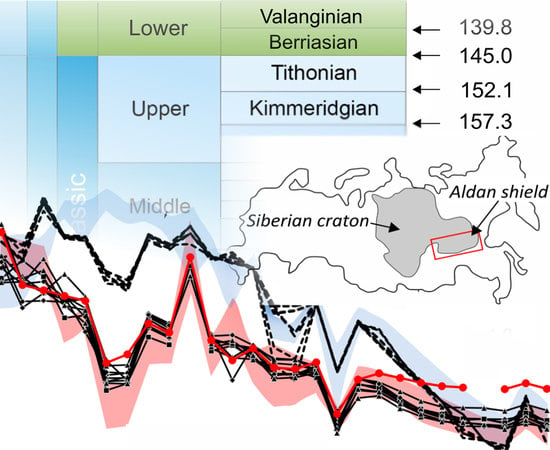40Ar/39Ar Geochronology and New Mineralogical and Geochemical Data from Lamprophyres of Chompolo Field (South Yakutia, Russia)
Abstract
:1. Introduction
2. Geological Background
3. Sampling and Analytical Techniques
3.1. Sample Preparation
3.2. Analytical Methods
4. Results
4.1. Petrography
4.2. Geochronology
4.3. Mineral Chemistry
4.3.1. Olivine
4.3.2. K-Feldspar
4.3.3. Clinopyroxene
4.3.4. Mica
4.3.5. Amphibole
4.3.6. Apatite
4.3.7. Garnets
4.3.8. Cr-Spinel
4.3.9. Ilmenite
4.4. Geochemistry
4.4.1. Major Elements
4.4.2. Trace Elements
4.4.3. Nd–Sr Isotopes
5. Discussion
5.1. Geochronology
5.2. Xenocrysts as Evidence of the Deep Mantle Source of the Rocks
5.3. Rock Classification Based on Mineralogical Features and Whole-Rock Chemistry
5.4. Isotopic and Trace Element Data
5.5. Metasomatic Mineral Assemblages in the Pyropes from the Central Aldan SCLM
5.6. Geodynamic Implications
6. Conclusions
Supplementary Materials
Author Contributions
Funding
Acknowledgments
Conflicts of Interest
References
- Smith, M.; Moore, K.; Kavecsánszki, D.; Finch, A.A.; Kynicky, J.; Wall, F. From mantle to critical zone: A review of large and giant sized deposits of the rare earth elements. Geosci. Front. 2016, 7, 315–334. [Google Scholar] [CrossRef] [Green Version]
- Goodenough, K.M.; Wall, F.; Merriman, D. The rare earth elements: Demand, global resources, and challenges for resourcing future generations. Nat. Resour. Res. 2018, 27, 201–216. [Google Scholar] [CrossRef] [Green Version]
- Atkinson, W.; Smith, C.; Boxer, G. The discovery and geology of the Argyle diamond deposits, Kimberley, Western Australia. In Proceedings of the Darwin Conference, Australasian Institute of Mining and Metallurgy, Darwin City, Australia, 5–9 August 1984; pp. 141–149. [Google Scholar]
- Jaques, A.; Lewis, J.; Smith, C.; Gregory, G.; Ferguson, J.; Chappell, B.; McCulloch, M. The diamond-bearing ultrapotassic (lamproitic) rocks of the West Kimberley region, Western Australia. In Developments in Petrology; Elsevier: Amsterdam, The Netherlands, 1984; Volume 11, pp. 225–254. [Google Scholar]
- Jaques, A.; Lewis, J.; Smith, C. The Kimberlites and Lamproites of Western Australia. Geol. Surv. West. Aust. Bull. 1986, 132, 268. [Google Scholar]
- Kaminsky, F.V. Non-kimberlitic diamondiferous igneous rocks: 25 years on. J. Geol. Soc. India 2007, 69, 557. [Google Scholar]
- Wyman, D.; Hollings, P.; Conceição, R. Geochemistry and radiogenic isotope characteristics of xenoliths in Archean diamondiferous lamprophyres: Implications for the Superior Province cratonic keel. Lithos 2015, 233, 111–130. [Google Scholar] [CrossRef]
- Nelson, D.R. Isotopic characteristics of potassic rocks: Evidence for the involvement of subducted sediments in magma genesis. Lithos 1992, 28, 403–420. [Google Scholar] [CrossRef]
- Vollmer, R. On the orgin of the Italian potassic magmas: 1. A discussion contribution. Chem. Geol. 1989, 74, 229–239. [Google Scholar] [CrossRef]
- Bogatikov, O.A.; Kononova, V.A.; Pervov, V.A.; Zhuravlev, D.Z. Petrogenesis of Mesozoic potassic magmatism of the Central Aldan: A Sr-Nd isotopic and geodynamic model. Int. Geol. Rev. 1994, 36, 629–644. [Google Scholar] [CrossRef]
- Davies, G.; Stolz, A.; Mahotkin, I.; Nowell, G.; Pearson, D. Trace element and Sr–Pb–Nd–Hf isotope evidence for ancient, fluid-dominated enrichment of the source of Aldan Shield lamproites. J. Petrol. 2006, 47, 1119–1146. [Google Scholar] [CrossRef] [Green Version]
- Maksimov, E.; Ugryumov, A. Mesozoic magmatic formations of the Aldan Shield. Sov. Geol. 1971, 7, 107–119. [Google Scholar]
- Mues-Schumacher, U.; Keller, J.; Kononova, V.; Suddaby, P. Mineral chemistry and geochronology of the potassic alkaline ultramafic Inagli complex, Aldan Shield, eastern Siberia. Mineral. Mag. 1996, 60, 711–730. [Google Scholar] [CrossRef]
- Bogatikov, O.; Ryabchikov, I.; Kononova, V.; Makhotkin, I.; Novgorodova, M.; Solovova, I.; Galuskin, E.; Ganeev, I.; Girnis, A.; Eremeev, N.; et al. Lamproites. Priroda. Moscow. 1991, 1991, 302. [Google Scholar]
- Kononova, V.; Bogatikov, O.; Kondrashov, I. Kimberlites and lamproites: Criteria for similarity and differences. Petrology 2011, 19, 34–54. [Google Scholar] [CrossRef]
- Panina, L.; Vladykin, N. Lamproitic rocks of the Murun Massif and their genesis. Russ. Geol. Geophys. 1994, 35, 100–113. [Google Scholar]
- Vavilov, M.; Bazarova, Y.; Podgornykh, N.; Krivoputskaya, L.; Kuznetsova, I. Characteristics and formation conditions of potassic alkaline rocks of the Loman Massif. Russ. Geol. Geophys. 1986, 27, 40–46. [Google Scholar]
- Vladykin, N. First find of lamproites in the USSR. Proc. Dokl. Akad. Nauk SSSR 1985, 280, 718–722. [Google Scholar]
- Shilina, G.; Zeitlin, S. About the first finding of the kimberlites on Aldan shield. Sov. Geol. 1959, 10, 132–136. [Google Scholar]
- Ashchepkov, I.; Vladykin, N.; Ntaflos, T.; Kostrovitsky, S.; Prokopiev, S.; Downes, H.; Smelov, A.; Agashev, A.; Logvinova, A.; Kuligin, S.; et al. Layering of the lithospheric mantle beneath the Siberian Craton: Modeling using thermobarometry of mantle xenolith and xenocrysts. Tectonophysics 2014, 634, 55–75. [Google Scholar] [CrossRef]
- Ashchepkov, I.; Pokhilenko, N.; Vladykin, N.; Logvinova, A.; Afanas’ev, V.; Pokhilenko, L.N.; Kuligin, S.S.; Malygina, E.V.; Alymova, N.A.; Kostrovitsky, S.I.; et al. Structure and evolution of the lithospheric mantle beneath Siberian craton, thermobarometric study. Tectonophysics 2010, 485, 17–41. [Google Scholar] [CrossRef]
- Ashchepkov, I.; Gerasimov, P.; Khmel’nikova, O.; Anoshin, G.; Vladykin, N.; Saprykin, A. Temperature gradient and structure of the lithospheric block beneath the southeastern margin of the Siberian craton: Disintegrated xenolith evidence from kimberlitic pipes of the Aldan shield. In Doklady Earth Sciences; Pleiades Publishing, Ltd.: New York, NY, USA, 2001; Volume 378, pp. 495–499. [Google Scholar]
- Kostrovitsky, S.; Garanin, V. High chromium titanates in pyropes dikes Aldan (Yakutia). Zap. RMO 1992, 121, 67–72. [Google Scholar]
- Utrobin, D. On the Question of the Dismemberment of the Jurassic-Cretaceous Deposits of South Yakutia. In Stratigraphy of the Precambrian and Phanerozoic of Transbaikalia and the south of the Far East; Earth Sciences: Khabarovsk, Russia, 1990; pp. 223–225. [Google Scholar]
- Kornilova, V. Petrography and mineralogy of the calc-alkaline lamprophyres and eruptive breccias at the basin of Chomppolo river. Otechestvennaya Geol. 1997, 9, 6–9. [Google Scholar]
- Panina, L. Lamproite rocks of the Aldan and genetic criteria of lamproite melts. Russ. Geol. Geophys. 1993, 34, 82–94. [Google Scholar]
- Rock, N. Nature and origin of calc-alkaline lamprophyres: Minettes, vogesites, kersantites and spessartites. Earth Environ. Sci. Trans. R. Soc. Edinb. 1984, 74, 193–227. [Google Scholar] [CrossRef]
- Paquette, J.-L.; Ionov, D.A.; Agashev, A.; Gannoun, A.; Nikolenko, E. Age, provenance and Precambrian evolution of the Anabar shield from U-Pb and Lu-Hf isotope data on detrital zircons, and the history of the northern and central Siberian craton. Precambrian Res. 2017, 301, 134–144. [Google Scholar] [CrossRef]
- Rosen, O. Siberian craton-a fragment of a Paleoproterozoic supercontinent. Russ. J. Earth Sci. 2002, 4, 103–119. [Google Scholar] [CrossRef] [Green Version]
- Smelov, A.P.; Timofeev, V.F. The age of the North Asian Cratonic basement: An overview. Gondwana Res. 2007, 12, 279–288. [Google Scholar] [CrossRef]
- Smelov, A.; Timofeev, V. The tectonics and metallogeny of the Precambrian of the Aldan-Stanovoy Shield. In Mineral Deposit Research: Meeting the Global Challenge; Springer: Berlin/Heidelberg, Germany, 2005; pp. 53–56. [Google Scholar]
- Smelov, A.P.; Yan, H.; Timofeev, V.F.; Prokopiev, A.V.; Nokleberg, W.J. Archean through Mesoproterozoic metallogenesis and tectonics of northeast Asia. In Metallogenesis and Tectonics of Northeast Asia; US Geological Survey: Reston, VA, USA, 2010; Chapter 4. [Google Scholar]
- Velikoslavinsky, S.; Kotov, A.; Sal’nikova, E.; Kovach, V.; Glebovitsky, V.; Zagornaya, N.Y.; Yakovleva, S.; Tolmacheva, E.; Anisimova, I.; Fedoseenko, A. Protoliths of the metamorphic rocks of the Fedorov Complex, Aldan Shield: Character, age, and geodynamic environments of origin. Petrology 2006, 14, 21–38. [Google Scholar] [CrossRef]
- Mues, U. Geochemische und Radiometrische Untersuchungen an Lamproiten und Anderen Alkaligesteinen von Yakokut und Inagli, Aldan-Schild, Ostsibirien. Ph.D. Thesis, University of Freiburg, Freiburg, Germany, 1993. [Google Scholar]
- Kononova, V.; Bogatikov, O.; Pervov, V.; Eremeev, N.; Suddaby, P. Geochemistry and origin of the potassic magmatic rocks of the Central Aldan. Geokhimiya 1994, 7, 937–955. [Google Scholar]
- Sorokin, A.A.; Zaika, V.A.; Kovach, V.P.; Kotov, A.B.; Xu, W.; Yang, H. Timing of closure of the eastern Mongol–Okhotsk Ocean: Constraints from U–Pb and Hf isotopic data of detrital zircons from metasediments along the Dzhagdy Transect. Gondwana Res. 2020, 81, 58–78. [Google Scholar] [CrossRef]
- Vladimirov, N.; Dauev, Y.; Zubarev, B. Geology and Genesis of Diamond Deposits; TsNIGRI: Moscow, Russia, 1989. [Google Scholar]
- Mudrik, S.; Anashin, M.; Pet’ko, V. Report on the Results of Prospecting for Diamonds Held Alekseevskoy GPP on Ust-Tokkiskoy and Chompolinskoy Areas in 1986–1988 Years (unpublished); Yakutskgeology: Alekseevsk, Russia, 1988; p. 475. [Google Scholar]
- Zaitsev, A.; Smelov, A. Isotope Geochronology of Kimberlite Rocks in the Yakutian Province; Ofset: Yakutsk, Russia, 2010; p. 108. [Google Scholar]
- Lavrent’ev, Y.G.; Korolyuk, V.; Usova, L.; Nigmatulina, E. Electron probe microanalysis of rock-forming minerals with a JXA-8100 electron probe microanalyzer. Russ. Geol. Geophys. 2015, 56, 1428–1436. [Google Scholar] [CrossRef]
- Nikolaeva, I.; Palesskii, S.; Koz’menko, O.; Anoshin, G. Analysis of geologic reference materials for REE and HFSE by inductively coupled plasma-mass spectrometry (ICP-MS). Geochem. Int. 2008, 46, 1016–1022. [Google Scholar] [CrossRef]
- Travin, A.; Yudin, D.; Vladimirov, A.; Khromykh, S.; Volkova, N.; Mekhonoshin, A.; Kolotilina, T.B. Thermochronology of the Chernorud granulite zone, Ol’khon Region, Western Baikal area. Geochem. Int. 2009, 47, 1107–1124. [Google Scholar] [CrossRef] [Green Version]
- Baksi, A.K.; Archibald, D.; Farrar, E. Intercalibration of 40Ar39Ar dating standards. Chem. Geol. 1996, 129, 307–324. [Google Scholar] [CrossRef]
- Lafuente, B.; Downs, R.; Yang, H.; Stone, N. The power of databases: The RRUFF project. In Highlights in Mineralogical Crystallography; Armbruster, T., Danisi, R.M., Eds.; De Gruyter: Berlin, Germany, 2015. [Google Scholar]
- Pin, C.; Joannon, S.; Bosq, C.; Le Fevre, B.; Gauthier, P.-J. Precise determination of Rb, Sr, Ba, and Pb in geological materials by isotope dilution and ICP-quadrupole mass spectrometry following selective separation of the analytes. J. Anal. Atom. Spectrom. 2003, 18, 135–141. [Google Scholar] [CrossRef]
- Bouvier, A.; Vervoort, J.D.; Patchett, P.J. The Lu–Hf and Sm–Nd isotopic composition of CHUR: Constraints from unequilibrated chondrites and implications for the bulk composition of terrestrial planets. Earth Planet. Sci. Lett. 2008, 273, 48–57. [Google Scholar] [CrossRef]
- Goldstein, S.J.; Jacobsen, S.B. Nd and Sr isotopic systematics of river water suspended material: Implications for crustal evolution. Earth Planet. Sci. Lett. 1988, 87, 249–265. [Google Scholar] [CrossRef]
- Whitney, D.L.; Evans, B.W. Abbreviations for names of rock-forming minerals. Am. Mineral. 2010, 95, 185–187. [Google Scholar] [CrossRef]
- Khar’kiv, A.; Vishnevsky, A. Pyrope Megacrysts with the Features of Partial Melting from Yakutian Kimberlites. Mineral. Zhur. 1989, 11, 28–36. [Google Scholar]
- Harrison, T.M. Diffusion of 40 Ar in hornblende. Contrib. Mineral. Petrol. 1982, 78, 324–331. [Google Scholar] [CrossRef]
- Whitehead, J.; Reynolds, P.H.; Spray, J.G. 40Ar/39Ar age constraints on Taconian and Acadian events in the Quebec Appalachians. Geology 1996, 24, 359–362. [Google Scholar] [CrossRef]
- Rock, N. The International Mineralogical Association (IMA/CNMMN) pyroxene nomenclature scheme: Computerization and its consequences. Mineral. Petrol. 1990, 43, 99–119. [Google Scholar] [CrossRef]
- Mitchell, R.H. Kimberlites and orangeites. In Kimberlites, Orangeites, and Related Rocks; Springer: Berlin/Heidelberg, Germany, 1995; pp. 1–90. [Google Scholar]
- Mitchell, R.H.; Bergman, S.C. Petrology of Lamproites; Springer Science & Business Media: Berlin, Germany, 1991. [Google Scholar]
- Tappe, S.; Foley, S.F.; Jenner, G.A.; Heaman, L.M.; Kjarsgaard, B.A.; Romer, R.L.; Stracke, A.; Joyce, N.; Hoefs, J. Genesis of ultramafic lamprophyres and carbonatites at Aillik Bay, Labrador: A consequence of incipient lithospheric thinning beneath the North Atlantic craton. J. Petrol. 2006, 47, 1261–1315. [Google Scholar] [CrossRef] [Green Version]
- Grütter, H.S.; Gurney, J.J.; Menzies, A.H.; Winter, F. An updated classification scheme for mantle-derived garnet, for use by diamond explorers. Lithos 2004, 77, 841–857. [Google Scholar] [CrossRef]
- Sobolev, N.; Lavrent’Ev, Y.G.; Pokhilenko, N.; Usova, L. Chrome-rich garnets from the kimberlites of Yakutia and their parageneses. Contrib. Mineral. Petrol. 1973, 40, 39–52. [Google Scholar] [CrossRef]
- Fitzpayne, A.; Giuliani, A.; Hergt, J.; Phillips, D.; Janney, P. New geochemical constraints on the origins of MARID and PIC rocks: Implications for mantle metasomatism and mantle-derived potassic magmatism. Lithos 2018, 318, 478–493. [Google Scholar] [CrossRef]
- Wyman, D.; Kerrich, R. Archean shoshonitic lamprophyres of the Abitibi Subprovince, Canada: Petrogenesis, age, and tectonic setting. J. Petrol. 1993, 34, 1067–1109. [Google Scholar] [CrossRef]
- Pandey, A.; Rao, N.C.; Pandit, D.; Pankaj, P.; Pandey, R.; Sahoo, S.; Kumar, A. Subduction–Tectonics in the evolution of the eastern Dharwar craton, southern India: Insights from the post-collisional calc-alkaline lamprophyres at the western margin of the Cuddapah basin. Precambrian Res. 2017, 298, 235–251. [Google Scholar] [CrossRef]
- Pandey, A.; Rao, N.C.; Chakrabarti, R.; Pankaj, P.; Pandit, D.; Pandey, R.; Sahoo, S. Post-collisional calc-alkaline lamprophyres from the Kadiri greenstone belt: Evidence for the Neoarchean convergence-related evolution of the Eastern Dharwar Craton and its schist belts. Lithos 2018, 320, 105–117. [Google Scholar] [CrossRef]
- Lanjewar, S.; Randive, K. Lamprophyres from the Harohalli dyke swarm in the Halaguru and Mysore areas, Southern India: Implications for backarc basin magmatism. J. Asian Earth Sci. 2018, 157, 329–347. [Google Scholar] [CrossRef]
- Choi, E.; Fiorentini, M.L.; Giuliani, A.; Foley, S.F.; Maas, R.; Taylor, W.R. Subduction-related petrogenesis of Late Archean calc-alkaline lamprophyres in the Yilgarn Craton (Western Australia). Precambrian Res. 2020, 338, 105550. [Google Scholar] [CrossRef]
- Carmichael, I.S. The mineralogy and petrology of the volcanic rocks from the Leucite Hills, Wyoming. Contrib. Mineral. Petrol. 1967, 15, 24–66. [Google Scholar] [CrossRef]
- Hwang, P.; Taylor, W.; Rocky, N.; Ramsay, R. Mineralogy, geochemistry and petrogenesis of the Metters Bore No. 1 lamproite pipe, Calwynyardah Field, West Kimberley Province, Western Australia. Miner. Petrol. 1994, 51, 195–226. [Google Scholar] [CrossRef]
- Reddy, T.A.K. Petrography and geochemistry of the Krishna lamproite field, Andhra Pradesh. J. Geol. Soc. India 2003, 61, 131-14. [Google Scholar]
- Kravchenko, S. Porphyric alkaline-ultrabasic potassic rocks of the central Tomtor Massif (Arctic Siberia): Carbonatized lamproites. Russ. Geol. Geophys. 2003, 44, 906–918. [Google Scholar]
- Rao, N.C.; Gibson, S.; Pyle, D.; Dickin, A. Petrogenesis of Proterozoic lamproites and kimberlites from the Cuddapah Basin and Dharwar craton, southern India. J. Petrol. 2004, 45, 907–948. [Google Scholar] [CrossRef] [Green Version]
- Rao, N.C.; Kamde, G.; Kale, H.; Dongre, A. Petrogenesis of the Mesoproterozoic lamproites from the Krishna valley, eastern Dharwar craton, southern India. Precambrian Res. 2010, 177, 103–130. [Google Scholar] [CrossRef]
- Rukhlov, A.S.; Blinova, A.I.; Pawlowicz, J.G. Geochemistry, mineralogy and petrology of the Eocene potassic magmatism from the Milk River area, southern Alberta, and Sweet Grass Hills, northern Montana. Chem. Geol. 2013, 353, 280–302. [Google Scholar] [CrossRef]
- Shaikh, A.M.; Patel, S.; Ravi, S.; Behera, D.; Pruseth, K. Mineralogy of the TK1 and TK4 ‘kimberlites’ in the Timmasamudram cluster, Wajrakarur Kimberlite Field, India: Implications for lamproite magmatism in a field of kimberlites and ultramafic lamprophyres. Chem. Geol. 2017, 455, 208–230. [Google Scholar] [CrossRef]
- Talukdar, D.; Pandey, A.; Rao, N.C.; Kumar, A.; Pandit, D.; Belyatsky, B.; Lehmann, B. Petrology and geochemistry of the Mesoproterozoic Vattikod lamproites, Eastern Dharwar Craton, southern India: Evidence for multiple enrichment of sub-continental lithospheric mantle and links with amalgamation and break-up of the Columbia supercontinent. Contrib. Mineral. Petrol. 2018, 173, 67. [Google Scholar] [CrossRef]
- Prelević, D.; Akal, C.; Foley, S.; Romer, R.; Stracke, A.; Van Den Bogaard, P. Ultrapotassic mafic rocks as geochemical proxies for post-collisional dynamics of orogenic lithospheric mantle: The case of southwestern Anatolia, Turkey. J. Petrol. 2012, 53, 1019–1055. [Google Scholar] [CrossRef]
- Çoban, H.; Flower, M.F. Mineral phase compositions in silica-undersaturated ‘leucite’ lamproites from the Bucak area, Isparta, SW Turkey. Lithos 2006, 89, 275–299. [Google Scholar] [CrossRef]
- Akal, C. K-richterite–olivine–phlogopite–diopside–sanidine lamproites from the Afyon volcanic province, Turkey. Geol. Mag. 2008, 145, 570–585. [Google Scholar] [CrossRef]
- Tappe, S.; Foley, S.F.; Stracke, A.; Romer, R.L.; Kjarsgaard, B.A.; Heaman, L.M.; Joyce, N. Craton reactivation on the Labrador Sea margins: 40Ar/39Ar age and Sr–Nd–Hf–Pb isotope constraints from alkaline and carbonatite intrusives. Earth Planet. Sci. Lett. 2007, 256, 433–454. [Google Scholar] [CrossRef]
- Nikolenko, E.; Afanas’ev, V.; Pokhilenko, N. Garnets of crustal parageneses in alluvial deposits of the eastern Siberian Platform: Genesis and search significance. Russ. Geol. Geophys. 2008, 49, 655–666. [Google Scholar] [CrossRef]
- Tychkov, N.; Pokhilenko, N.; Kuligin, S.; Malygina, E. Composition and origin of peculiar pyropes from lherzolites: Evidence for the evolution of the lithospheric mantle of the Siberian Platform. Russ. Geol. Geophys. 2008, 49, 225–239. [Google Scholar] [CrossRef]
- Sobolev, N.; Lavrent’ev, Y.; Pospelova, L.; Sobolev, E. Chrome pyropes from the diamonds of Yakutia. Dokl. Akad. Nauk SSSR 1969, 189, 162–165. [Google Scholar]
- Schulze, D.J. A classification scheme for mantle-derived garnets in kimberlite: A tool for investigating the mantle and exploring for diamonds. Lithos 2003, 71, 195–213. [Google Scholar] [CrossRef]
- Sobolev, N. On mineralogical criteria of a diamond potential of kimberlites. Geol. I Geofiz. 1971, 12, 70–78. [Google Scholar]
- Kampata, M.; Moreau, J.; Hertogen, J.; Demaiffe, D.; Condliffe, E.; Mvuemba, N. Megacrysts and ultramafic xenoliths from Kundelungu kimberlites (Shaba, Zaire). Mineral. Mag. 1995, 59, 661–676. [Google Scholar] [CrossRef]
- Robles-Cruz, S.E.; Watangua, M.; Isidoro, L.; Melgarejo, J.C.; Galí, S.; Olimpio, A. Contrasting compositions and textures of ilmenite in the Catoca kimberlite, Angola, and implications in exploration for diamond. Lithos 2009, 112, 966–975. [Google Scholar] [CrossRef]
- Nikolenko, E.; Afanas’ev, V.; Pokhilenko, N. Peculiarities of the composition of zoned picroilmenites from the Massadou field (Giunea) and Dachnaya pipe (Yakutia) kimberlites. Dokl. Earth. Sci. 2010, 434, 1386. [Google Scholar] [CrossRef]
- Foley, S.; Venturelli, G.; Green, D.; Toscani, L. The ultrapotassic rocks: Characteristics, classification, and constraints for petrogenetic models. Earth-Sci. Rev. 1987, 24, 81–134. [Google Scholar] [CrossRef]
- Irvine, T.; Baragar, W. A guide to the chemical classification of the common volcanic rocks. Can. J. Earth Sci. 1971, 8, 523–548. [Google Scholar] [CrossRef]
- Kostrovitsky, S.; Morikiyo, T.; Serov, I.; Yakovlev, D.; Amirzhanov, A. Isotope-geochemical systematics of kimberlites and related rocks from the Siberian Platform. Russ. Geol. Geophys. 2007, 48, 272–290. [Google Scholar] [CrossRef]
- Mirnejad, H.; Bell, K. Origin and source evolution of the Leucite Hills lamproites: Evidence from Sr–Nd–Pb–O isotopic compositions. J. Petrol. 2006, 47, 2463–2489. [Google Scholar] [CrossRef]
- Chen, Y.; Yao, S.; Pan, Y. Geochemistry of lamprophyres at the Daping gold deposit, Yunnan Province, China: Constraints on the timing of gold mineralization and evidence for mantle convection in the eastern Tibetan Plateau. J. Asian Earth Sci. 2014, 93, 129–145. [Google Scholar] [CrossRef]
- Chen, B.; Zhai, M. Geochemistry of late Mesozoic lamprophyre dykes from the Taihang Mountains, north China, and implications for the sub-continental lithospheric mantle. Geol. Mag. 2003, 140, 87–93. [Google Scholar] [CrossRef]
- Wyman, D.; Ayer, J.; Conceição, R.; Sage, R. Mantle processes in an Archean orogen: Evidence from 2.67 Ga diamond-bearing lamprophyres and xenoliths. Lithos 2006, 89, 300–328. [Google Scholar] [CrossRef]
- Wyman, D.; Kerrich, R. Archean lamprophyre dikes of the Superior Province, Canada: Distribution, petrology, and geochemical characteristics. J. Goephys. Res.-Sol. Ea. 1989, 94, 4667–4696. [Google Scholar] [CrossRef]
- Leat, P.; Thompson, R.; Morrison, M.; Hendry, G.; Dickin, A. Silicic magmas derived by fractional crystallization from Miocene minette, Elkhead Mountains, Colorado. Mineral. Mag. 1988, 52, 577–585. [Google Scholar] [CrossRef]
- Sun, S.-S.; McDonough, W.F. Chemical and isotopic systematics of oceanic basalts: Implications for mantle composition and processes. J. Geol. Soc. Lond. 1989, 42, 313–345. [Google Scholar] [CrossRef]
- McDonough, W.F.; Sun, S.-S. The composition of the Earth. Chem. Geol. 1995, 120, 223–253. [Google Scholar] [CrossRef]
- Kempton, P.; Fitton, J.; Hawkesworth, C.; Ormerod, D. Isotopic and trace element constraints on the composition and evolution of the lithosphere beneath the southwestern United States. J. Geophys. Res.-Sol. Earth 1991, 96, 13713–13735. [Google Scholar] [CrossRef]
- Wannamaker, P.E.; Hulen, J.B.; Heizler, M.T. Early Miocene lamproite from the Colorado Plateau tectonic province, southeastern Utah, USA. J. Volcanol. Geotherm. Res. 2000, 96, 175–190. [Google Scholar] [CrossRef]
- Schleicher, H.; Lippolt, H.J.; Raczek, I. Rb-Sr systematics of Permian volcanites in the Schwarzwald (SW-Germany). Contrib. Mineral. Petrol. 1983, 84, 281–291. [Google Scholar] [CrossRef]
- Wright, J. The phonolite-trachyte spectrum. Lithos 1971, 4, 1–5. [Google Scholar] [CrossRef]
- Ehrenberg, S.N. Garnetiferous ultramafic inclusions in minette from the Navajo volcanic field. Mantle Sample Incl. Kimberl. Other Volcan. 1979, 16, 330–344. [Google Scholar] [CrossRef]
- Panina, L. Low-titanium Aldan lamproites (Siberia): Melt inclusions in minerals. Russ. Geol. Geophys. 1997, 38, 118–127. [Google Scholar]
- Vladykin, N. Geochemistry and genesis of lamproites of the Aldan Shield. In Proceedings of the International Kimberlite Conference: Extended Abstracts, Novosibirsk, Russia, 19 September 1995; Volume 6, pp. 660–662. [Google Scholar]
- Nikolenko, E.I.; Sharygin, I.S.; Alifirova, T.A.; Korsakov, A.V.; Zelenovskiy, P.S.; Shur, V.Y. Graphite-bearing mineral assemblages in the mantle beneath Central Aldan superterrane of North Asian craton: Combined confocal micro-Raman and electron microprobe characterization. J. Raman Spectrosc. 2017, 48, 1597–1605. [Google Scholar] [CrossRef]
- Ashchepkov, I.; Vladykin, N.; Saprykin, A.; Khmelnikova, O.; Anoshin, G. Composition and thermal structure of the mantle in peripheral parts of Siberian craton. Rev. Bras. Geo. 2001, 31, 527–536. [Google Scholar] [CrossRef] [Green Version]
- Le Maitre, R.; Streckeisen, A.; Zanettin, B.; Le Bas, M.; Bonin, B.; Bateman, P. Igneous Rocks: A Classification and Glossary of Terms: Recommendations of the International Union of Geological Sciences Subcommission on the Systematics of Igneous Rocks; Cambridge University Press: Cambridge, UK, 2005. [Google Scholar]
- Vasilenko, V.; Zinchuk, N.; Kuznetsova, L. Petrochemical Models for Diamond Deposits in Yakutia; Nauka Novosibirsk: Moscow, Russia, 1997. (In Russian) [Google Scholar]
- Mitchell, R.H.; Giuliani, A.; O’Brien, H. What is a kimberlite? Petrology and mineralogy of hypabyssal kimberlites. Elem. Int. Mag. Mineral. Geochem. Petrol. 2019, 15, 381–386. [Google Scholar] [CrossRef]
- Cox, K.G. The Interpretation of Igneous Rocks; Springer Science & Business Media: Berlin, Germany, 2013. [Google Scholar]
- Woolley, A.R.; Bergman, S.C.; Edgar, A.D.; Le Bas, M.J.; Mitchell, R.H.; Rock, N.M.; Scott Smith, B.H. Classification of lamprophyres, lamproites, kimberlites, and the kalsilitic, melilitic, and leucitic rocks. Can. Mineral. 1996, 34, 175–186. [Google Scholar]
- Rock, N.; Bowes, D.; Wright, A. Lamprophyres; Blackie: Glasgow, UK, 1991. [Google Scholar]
- Mitchell, R.H. Kimberlites: Mineralogy, Geochemistry, and Petrology; Springer Science & Business Media: Berlin, Germany, 2013. [Google Scholar]
- Nemec, D. Origin of syenite porphyries in the Central Bohemian Pluton by magma mixing. Neues Jahrb. Mineral. Abh. 1988, 159, 59–71. [Google Scholar]
- Zliao, D.; Smitn, D.; Yang, J.; Deng, C.; Huang, Y. The Yinniugou lamproites in datong, Northern Shanxi province, China: First occurrence in the North China craton. In Proceedings of the Mid-Continent Diamonds: GAC-MAC Symposium Volume, Edmonton, Alberta, 17–18 May 1993; p. 139. [Google Scholar]
- Sharygin, I.S.; Nikolenko, E.I.; Lobov, K.V. Carbonate inclusions in Cr-pyropes derived from the mantle beneath Central Aldan superterrane of Siberian craton. In Proceedings of the International Kimberlite Conference: Extended Abstracts, Gaborone, Botswana, 18–22 September 2017; Volume 11, pp. 1–3. [Google Scholar]
- Exley, R.; Smith, J. The role of apatite in mantle enrichment processes and in the petrogenesis of some alkali basalt suites. Geochim. Cosmochim. Acta 1982, 46, 1375–1384. [Google Scholar] [CrossRef]
- Smith, B.S.; Skinner, E. A new look at Prairie Creek, Arkansas. In Developments in Petrology; Elsevier: Amsterdam, The Netherlands, 1984; Volume 11, pp. 255–283. [Google Scholar]
- Soltys, A.; Giuliani, A.; Phillips, D. Apatite compositions and groundmass mineralogy record divergent melt/fluid evolution trajectories in coherent kimberlites caused by differing emplacement mechanisms. Contrib. Mineral. Petrol. 2020, 175. [Google Scholar] [CrossRef]
- Dalton, H.; Giuliani, A.; O’Brien, H.; Phillips, D.; Hergt, J.; Maas, R. Petrogenesis of a hybrid cluster of evolved kimberlites and ultramafic lamprophyres in the Kuusamo area, Finland. J. Petrol. 2019, 60, 2025–2050. [Google Scholar] [CrossRef]
- Bergman, S.C. Lamproites and other potassium-rich igneous rocks: A review of their occurrence, mineralogy and geochemistry. GSL SP 1987, 30, 103–190. [Google Scholar] [CrossRef]
- Rock, N.M. The nature and origin of lamprophyres: An overview. J. Geol. Soc. Lond. 1987, 30, 191–226. [Google Scholar] [CrossRef]
- Vladykin, N. Potassium alkaline lamproite-carbonatite complexes: Petrology, genesis, and ore reserves. Russ. Geol. Geophys. 2009, 50, 1119–1128. [Google Scholar] [CrossRef]
- Doroshkevich, A.G.; Prokopyev, I.R.; Izokh, A.E.; Klemd, R.; Ponomarchuk, A.V.; Nikolaeva, I.V.; Vladykin, N.V. Isotopic and trace element geochemistry of the Seligdar magnesiocarbonatites (South Yakutia, Russia): Insights regarding the mantle evolution beneath the Aldan-Stanovoy shield. J. Asian Earth Sci. 2018, 154, 354–368. [Google Scholar] [CrossRef]
- Scambelluri, M.; Van Roermund, H.L.; Pettke, T. Mantle wedge peridotites: Fossil reservoirs of deep subduction zone processes: Inferences from high and ultrahigh-pressure rocks from Bardane (Western Norway) and Ulten (Italian Alps). Lithos 2010, 120, 186–201. [Google Scholar] [CrossRef]
- Bebout, G.E. Metasomatism in subduction zones of subducted oceanic slabs, mantle wedges, and the slab-mantle interface. In Metasomatism and the Chemical Transformation of Rock; Springer: Berlin, Germany, 2013; pp. 289–349. [Google Scholar]
- Plank, T. Constraints from thorium/lanthanum on sediment recycling at subduction zones and the evolution of the continents. JPET 2005, 46, 921–944. [Google Scholar] [CrossRef] [Green Version]
- Pearce, J.A. Role of the sub-continental lithosphere in magma genesis at active continental margins. In Continental Basalts and Mantle Xenoliths; Shiva Publications: Nantwich, UK, 1983; pp. 230–249. [Google Scholar]
- Rudnick, R.; Gao, S. Composition of the continental crust. Crust 2003, 3, 1–64. [Google Scholar] [CrossRef]
- Pearce, J. Geochemical fingerprinting of oceanic basalts with applications to ophiolite classification and the search for Archean oceanic crust. Lithos 2008, 14–48. [Google Scholar] [CrossRef]
- Turner, S.; Arnaud, N.; Liu, J.; Rogers, N.; Hawkesworth, C.; Harris, N.; Kelley, S.; Van Calsteren, P.; Deng, W. Post-collision, shoshonitic volcanism on the Tibetan Plateau: Implications for convective thinning of the lithosphere and the source of ocean island basalts. J. Petrol. 1996, 37, 45–71. [Google Scholar] [CrossRef]
- Williams, H.M.; Turner, S.P.; Pearce, J.A.; Kelley, S.; Harris, N. Nature of the source regions for post-collisional, potassic magmatism in southern and northern Tibet from geochemical variations and inverse trace element modelling. J. Petrol. 2004, 45, 555–607. [Google Scholar] [CrossRef]
- Plank, T. The Chemical Composition of Subducting Sediments; Elsevier: Amsterdam, The Netherlands, 2014. [Google Scholar]
- Guo, Z.; Wilson, M. The Himalayan leucogranites: Constraints on the nature of their crustal source region and geodynamic setting. Gondwana Res. 2012, 22, 360–376. [Google Scholar] [CrossRef]
- Kepezhinskas, P.; McDermott, F.; Defant, M.J.; Hochstaedter, A.; Drummond, M.S.; Hawkesworth, C.J.; Koloskov, A.; Maury, R.C.; Bellon, H. Trace element and Sr Nd Pb isotopic constraints on a three-component model of Kamchatka Arc petrogenesis. Geochim. Cosmochim. Acta 1997, 61, 577–600. [Google Scholar] [CrossRef]
- Hofmann, A.W. Chemical differentiation of the Earth: The relationship between mantle, continental crust, and oceanic crust. Earth Planet. Sci. Lett. 1988, 90, 297–314. [Google Scholar] [CrossRef] [Green Version]
- Bulatov, V.; Brey, G.; Girnis, A.; Gerdes, A.; Höfer, H. Carbonated sediment–peridotite interaction and melting at 7.5–12 GPa. Lithos 2014, 200, 368–385. [Google Scholar] [CrossRef]
- Stalder, R.; Foley, S.; Brey, G.; Horn, I. Mineral-aqueous fluid partitioning of trace elements at 900–1200 C and 3.0–5.7 GPa: New experimental data for garnet, clinopyroxene, and rutile, and implications for mantle metasomatism. Geochim. Cosmochim. Acta 1998, 62, 1781–1801. [Google Scholar] [CrossRef]
- Anders, E.; Grevesse, N. Abundances of the elements: Meteoritic and solar. Geochim. Cosmochim. Acta 1989, 53, 197–214. [Google Scholar] [CrossRef]
- Gao, Y.; Hou, Z.; Kamber, B.S.; Wei, R.; Meng, X.; Zhao, R. Lamproitic rocks from a continental collision zone: Evidence for recycling of subducted Tethyan oceanic sediments in the mantle beneath southern Tibet. J. Petrol. 2007, 48, 729–752. [Google Scholar] [CrossRef]
- Su, H.-M.; Jiang, S.-Y.; Zhang, D.-Y.; Wu, X.-K. Partial melting of subducted sediments produced early Mesozoic calc-alkaline lamprophyres from northern Guangxi Province, South China. Sci. Rep. 2017. [Google Scholar] [CrossRef] [PubMed] [Green Version]
- Feldstein, S.N.; Lange, R.A. Pliocene potassic magmas from the Kings River region, Sierra Nevada, California: Evidence for melting of a subduction-modified mantle. J. Petrol. 1999, 40, 1301–1320. [Google Scholar] [CrossRef]
- Furman, T.; Graham, D. Erosion of lithospheric mantle beneath the East African Rift system: Geochemical evidence from the Kivu volcanic province. In Developments in Geotectonics; Elsevier: Amsterdam, The Netherlands, 1999; Volume 24, pp. 237–262. [Google Scholar]
- Guo, Z.; Hertogen, J.; Liu, J.; Pasteels, P.; Boven, A.; Punzalan, L.; He, H.; Luo, X.; Zhang, W. Potassic magmatism in western Sichuan and Yunnan provinces, SE Tibet, China: Petrological and geochemical constraints on petrogenesis. J. Petrol. 2004, 46, 33–78. [Google Scholar] [CrossRef]
- Konzett, J.; Wirth, R.; Hauzenberger, C.; Whitehouse, M. Two episodes of fluid migration in the Kaapvaal Craton lithospheric mantle associated with Cretaceous kimberlite activity: Evidence from a harzburgite containing a unique assemblage of metasomatic zirconium-phases. Lithos 2013, 182, 165–184. [Google Scholar] [CrossRef]
- Rezvukhin, D.I.; Malkovets, V.G.; Sharygin, I.S.; Tretiakova, I.G.; Griffin, W.L.; O’Reilly, S.Y. Inclusions of crichtonite-group minerals in Cr-pyropes from the Internatsionalnaya kimberlite pipe, Siberian Craton: Crystal chemistry, parageneses and relationships to mantle metasomatism. Lithos 2018, 308, 181–195. [Google Scholar] [CrossRef]
- Rezvukhin, D.; Nikolenko, E.; Sharygin, I.; Malkovets, V. Oxide mineral inclusions in Cr-pyropes from the Aldanskaya lamprophyre dyke, Yakutia. In Proceedings of the Magmatism of the Earth and Related Strategic Metal Deposits, Miass, Russia, 4–9 August 2017; pp. 205–208. [Google Scholar]
- Alifirova, T.; Rezvukhin, D.; Nikolenko, E.; Pokhilenko, L.; Zelenovskiy, P.; Sharygin, I.; Korsakov, A.; Shur, V. Micro-Raman study of crichtonite group minerals enclosed into mantle garnet. J. Raman Spectrosc. 2020, 51, 1493–1512. [Google Scholar] [CrossRef]
- Lustrino, M.; Agostini, S.; Chalal, Y.; Fedele, L.; Stagno, V.; Colombi, F.; Bouguerra, A. Exotic lamproites or normal ultrapotassic rocks? The Late Miocene volcanic rocks from Kef Hahouner, NE Algeria, in the frame of the circum-Mediterranean lamproites. J. Volcanol. Geotherm. Res. 2016, 327, 539–553. [Google Scholar] [CrossRef]
- Mitchell, R.; Smith, C.; Vladykin, N. Isotopic composition of strontium and neodymium in potassic rocks of the Little Murun complex, Aldan Shield, Siberia. Lithos 1994, 32, 243–248. [Google Scholar] [CrossRef]
- Vladykin, N.; Morikiyo, T.; Miyazaki, T. Sr and Nd isotopes geochemistry of alkaline and carbonatite complexes of Siberia and Mongolia and some geodynamic consequences. In Proceedings of the 5th International Conference “Problems of Sources of Deep Magmatism and Plumes”, Petropavlovsk-Kamchatskiy, Russia, 23 October 2005; pp. 19–37. [Google Scholar]
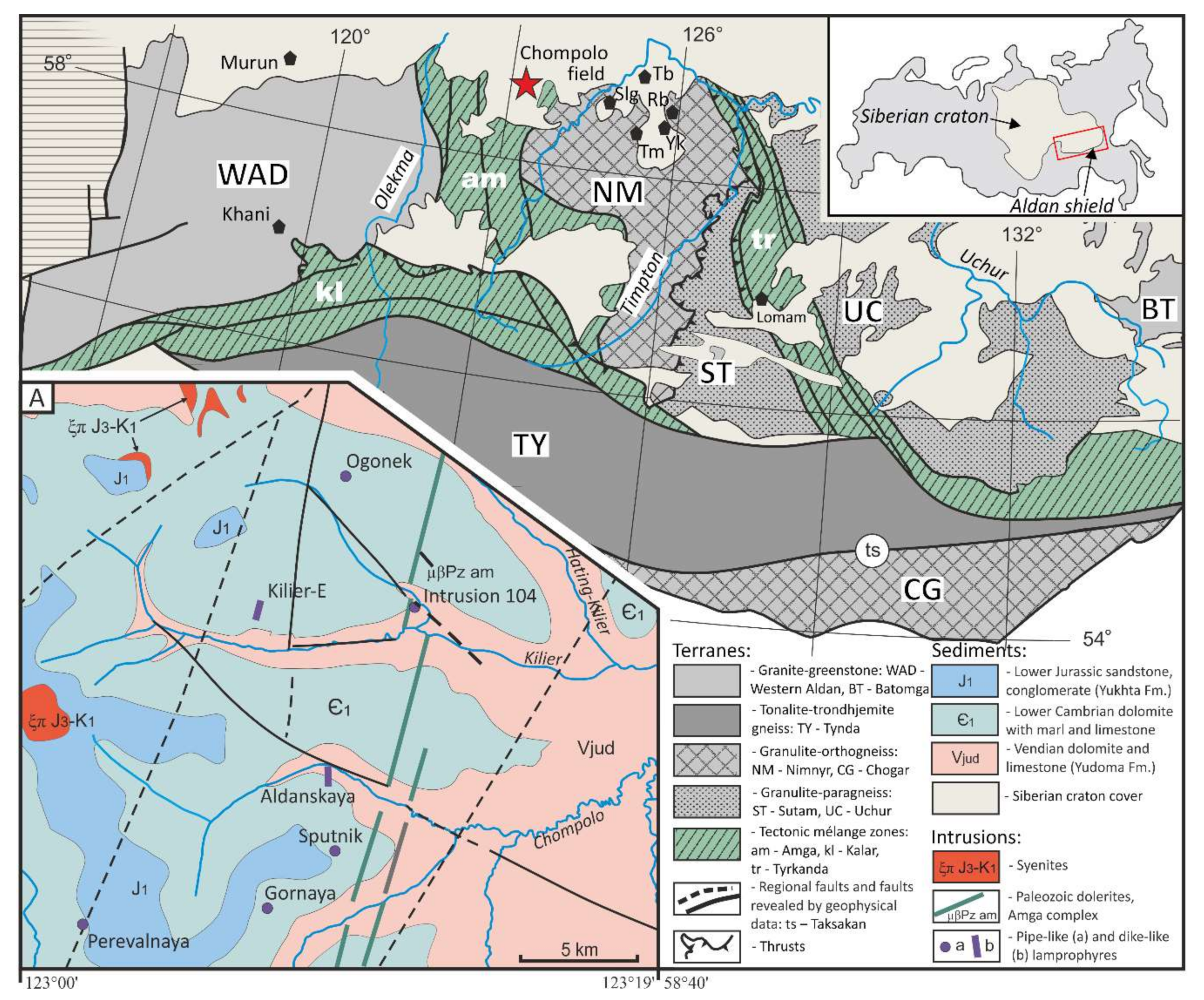
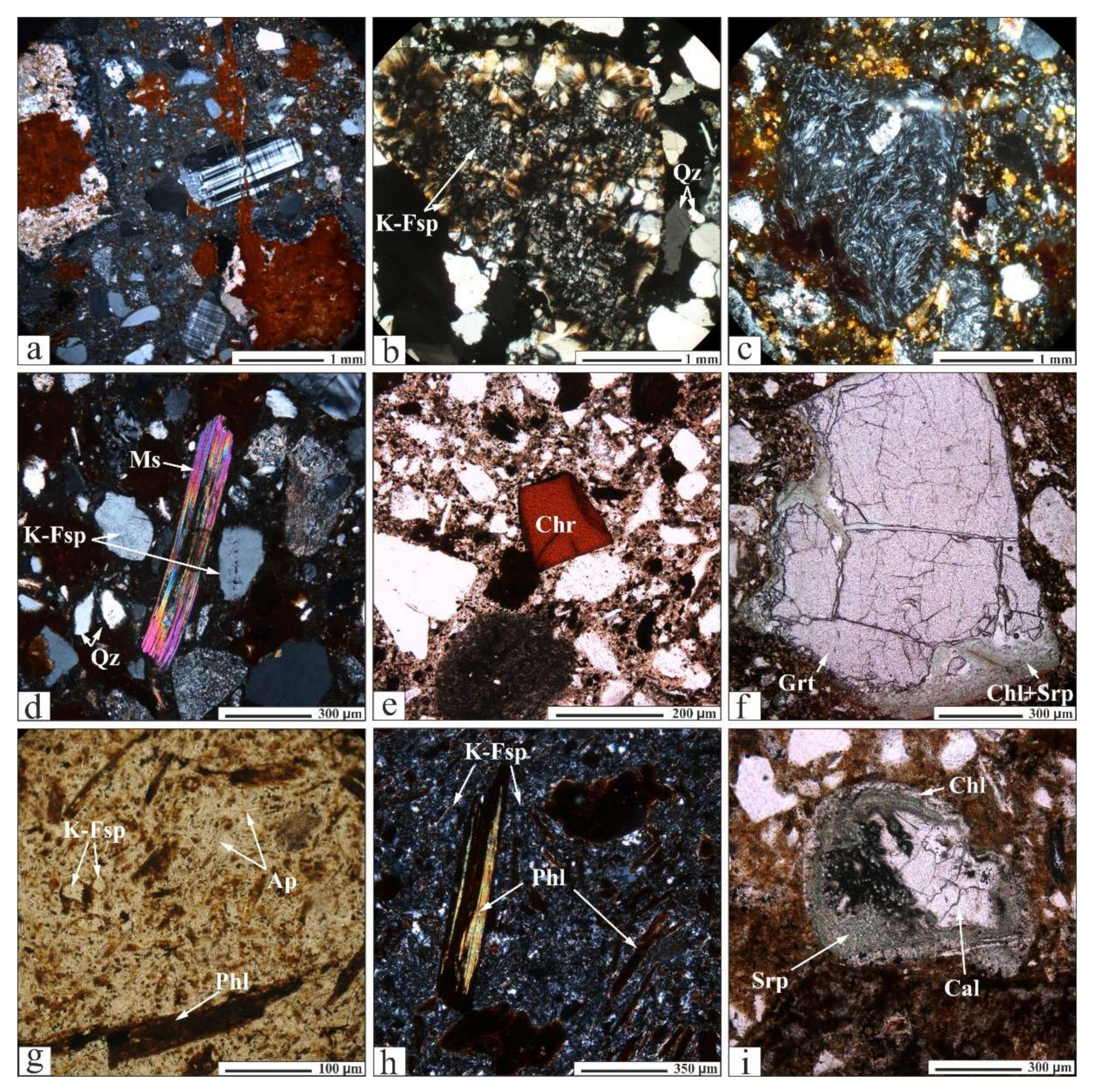
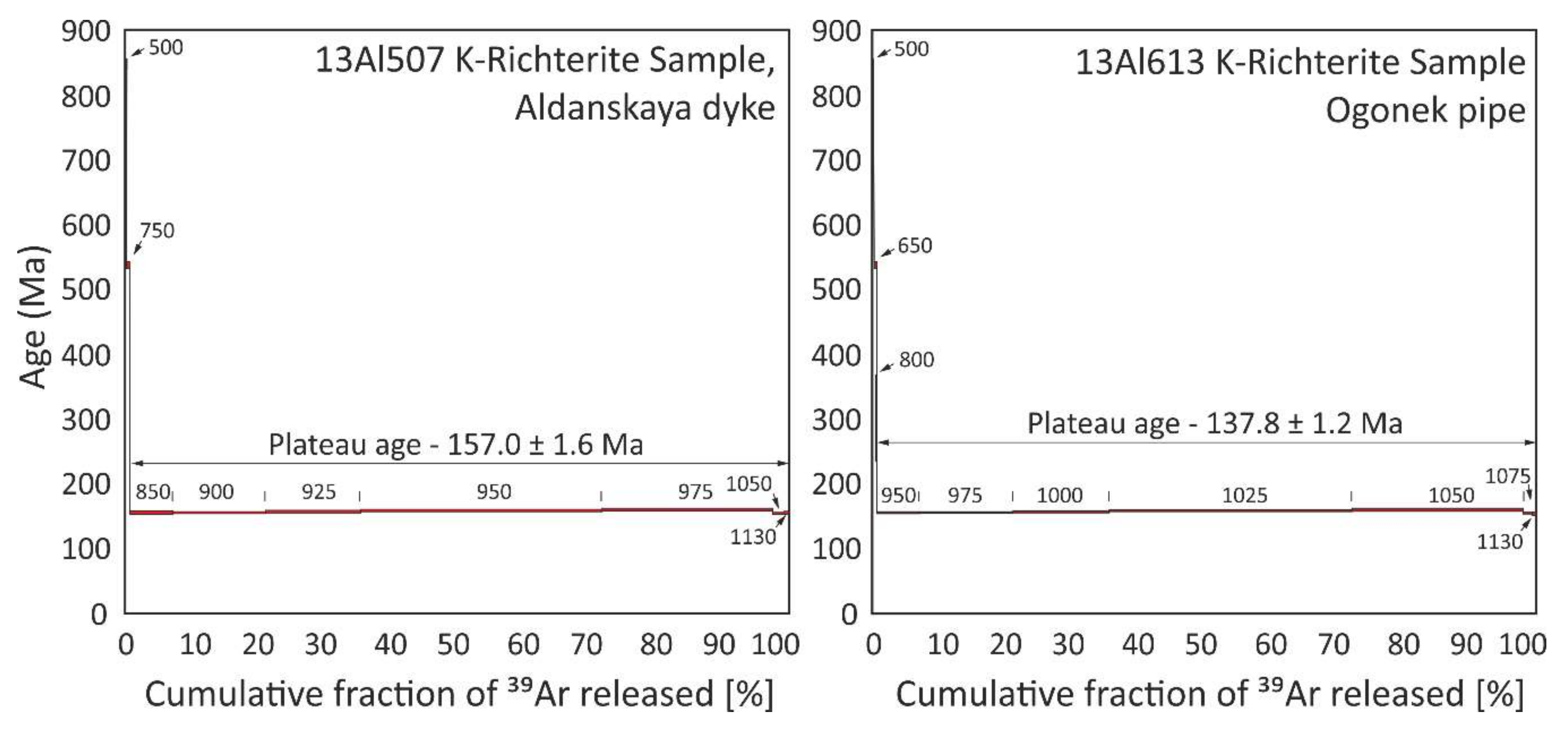
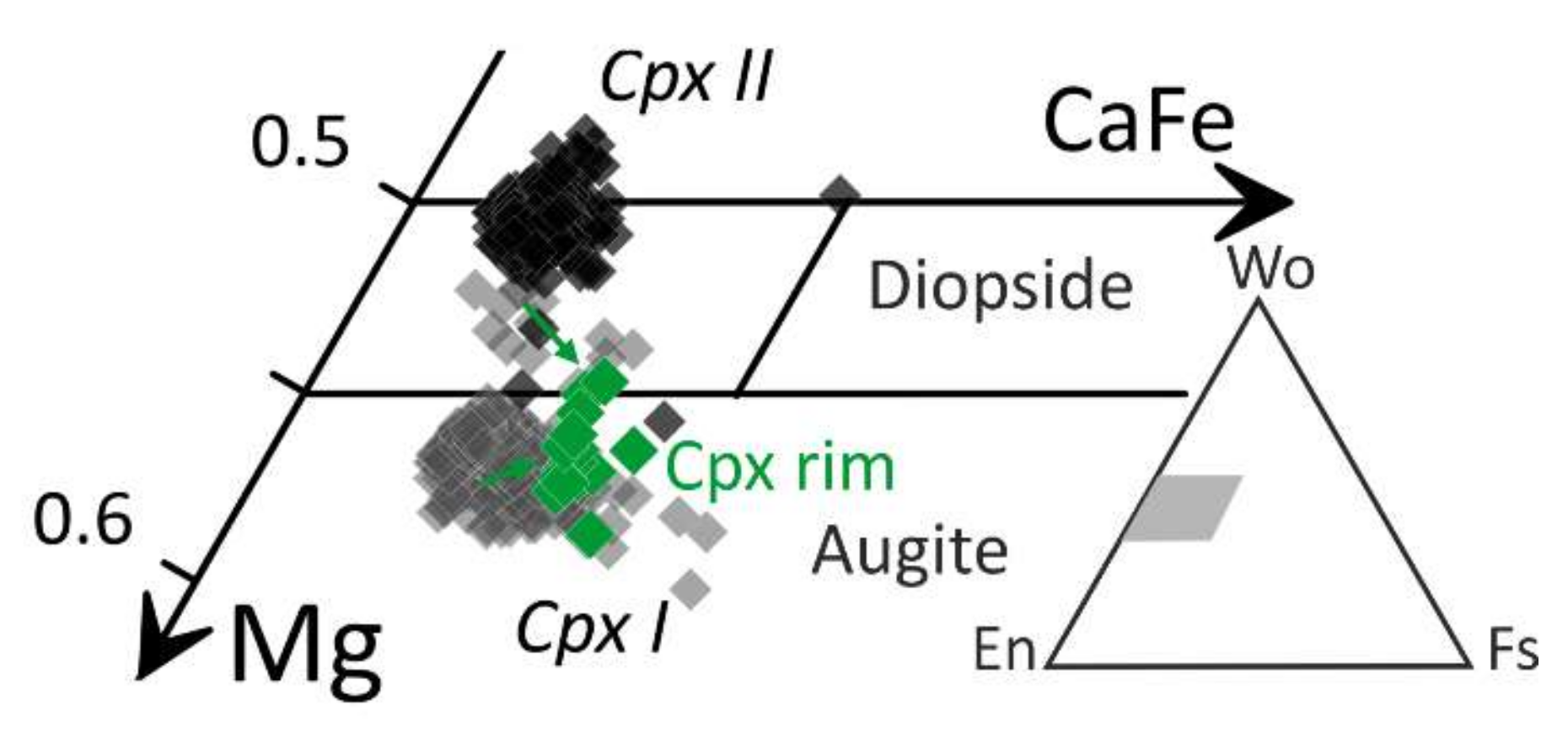
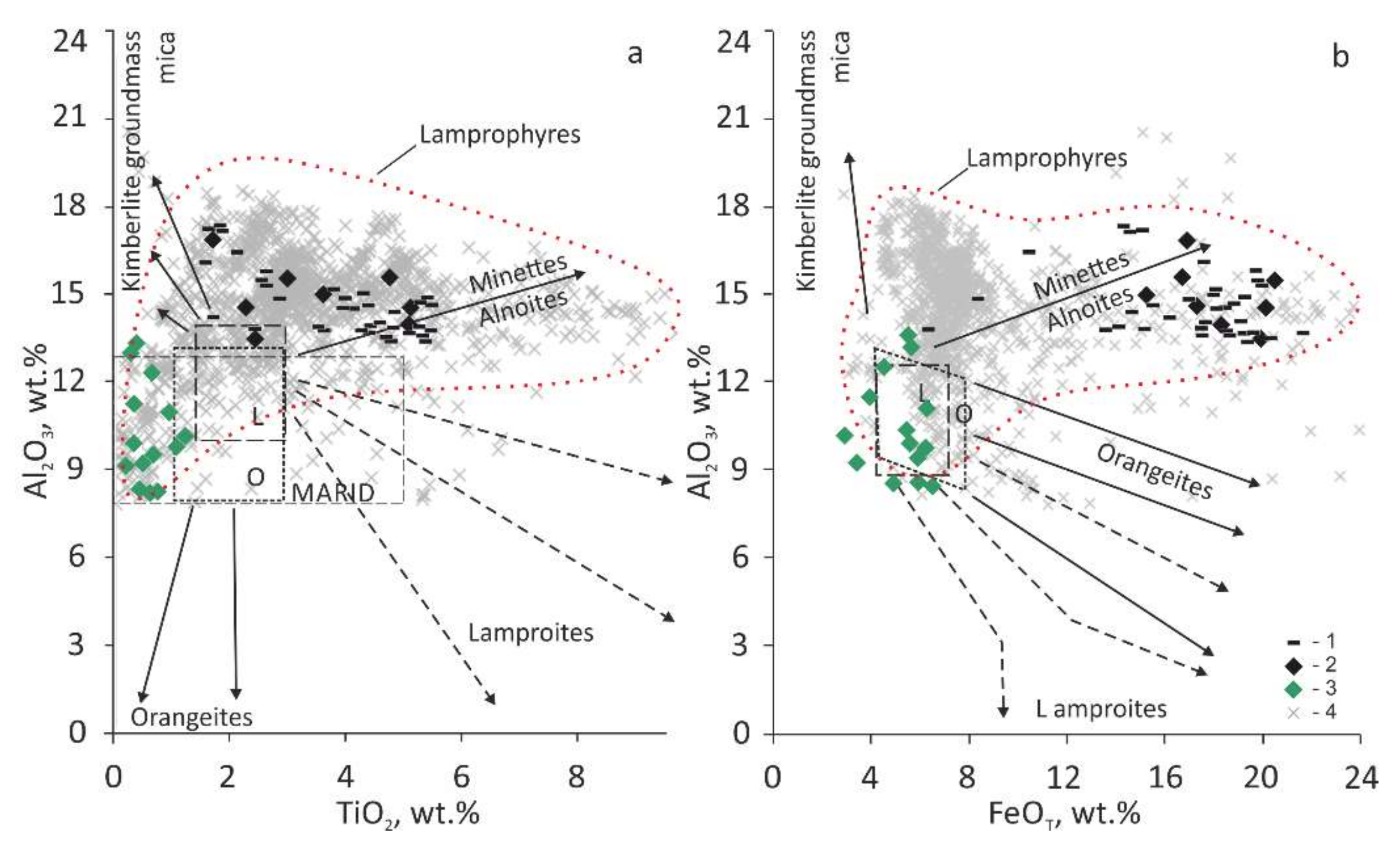
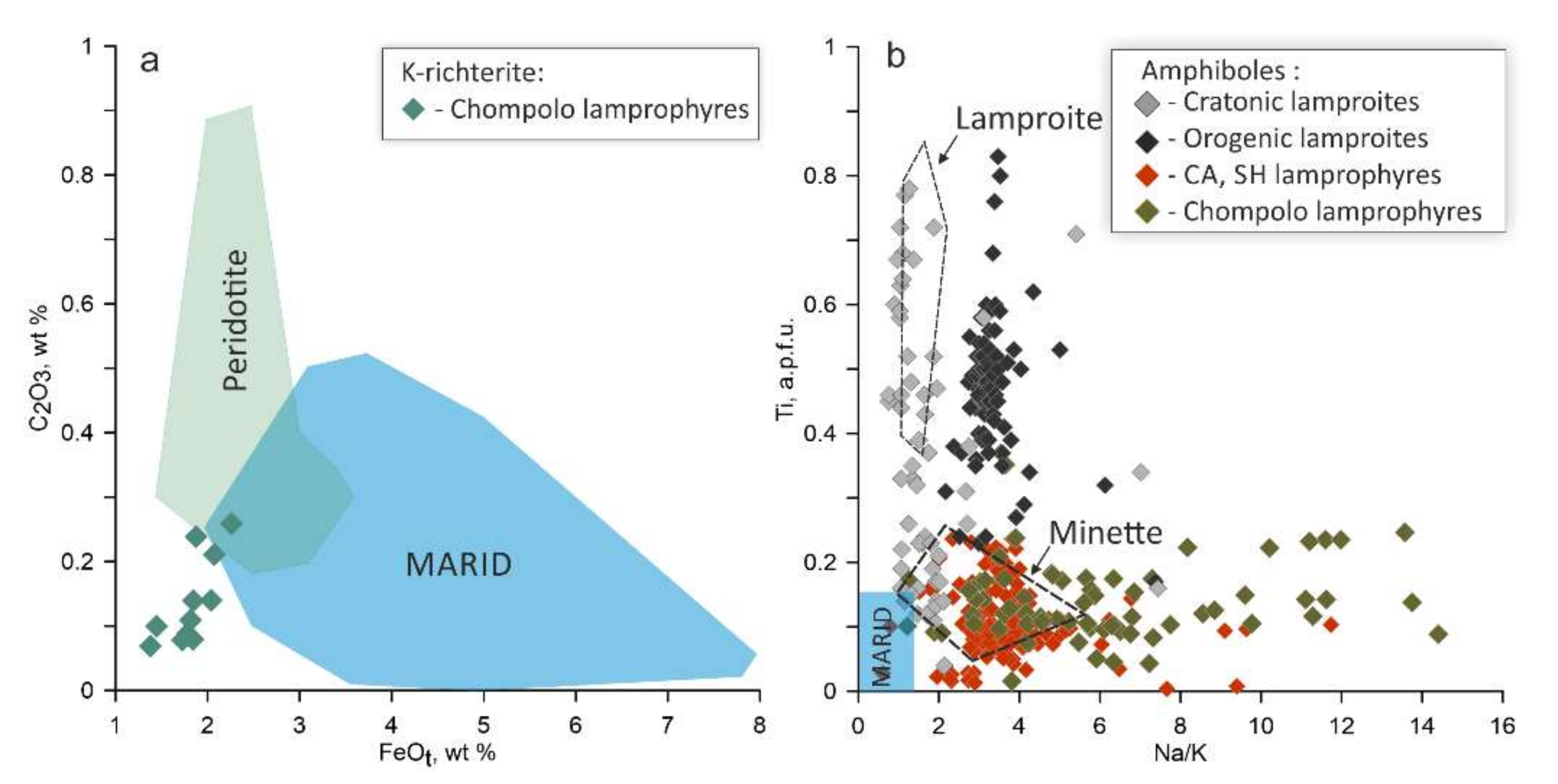
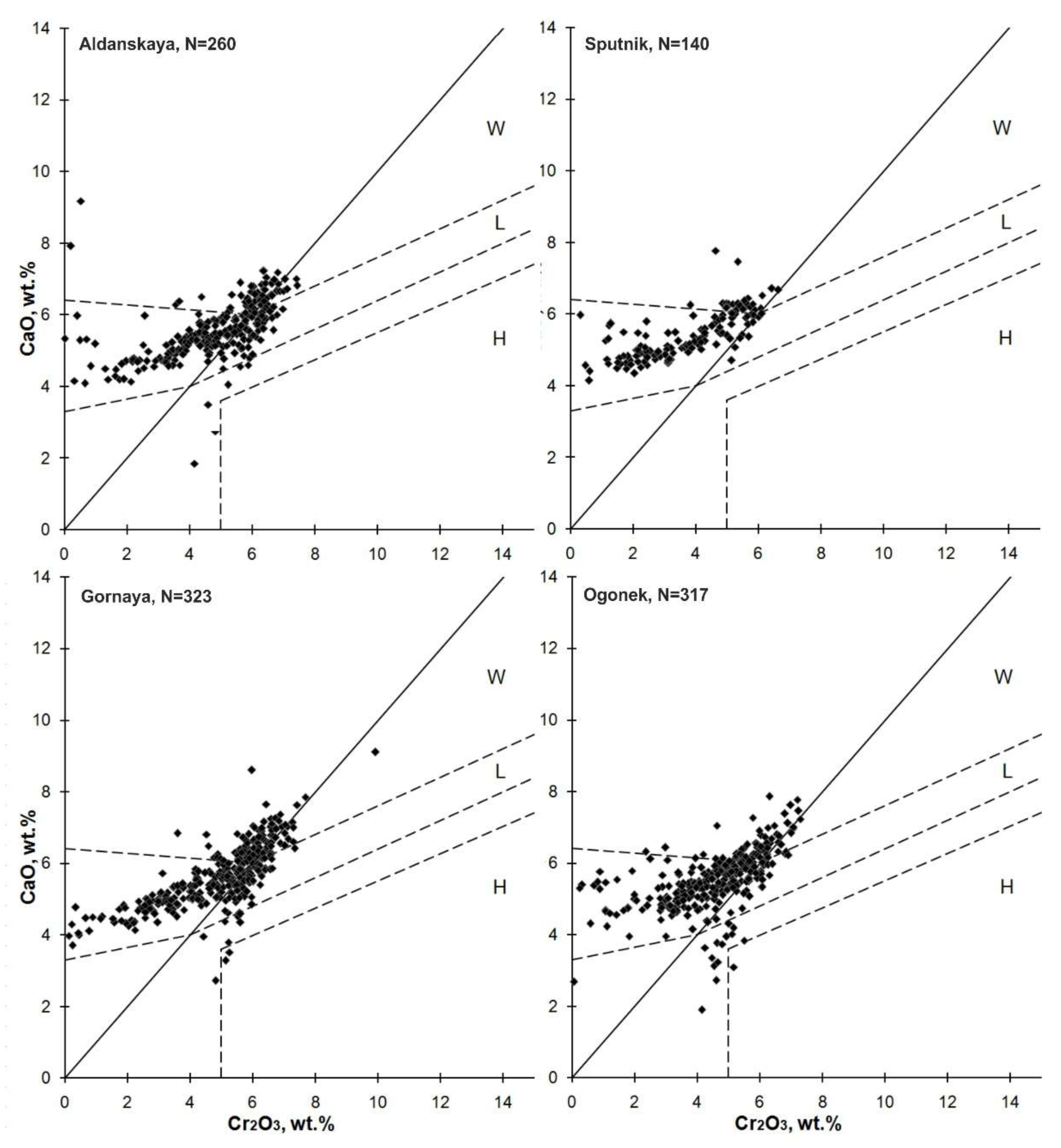

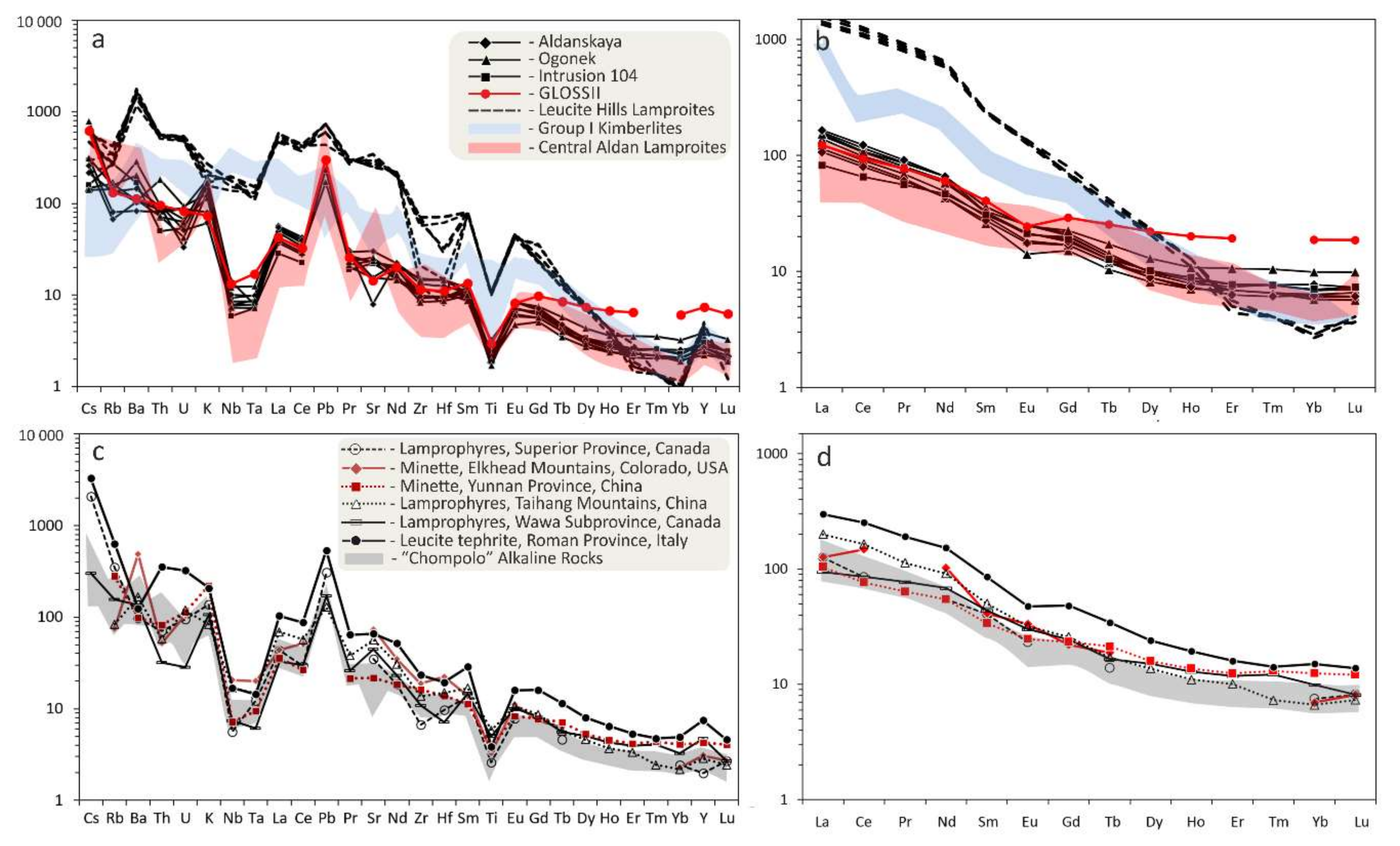
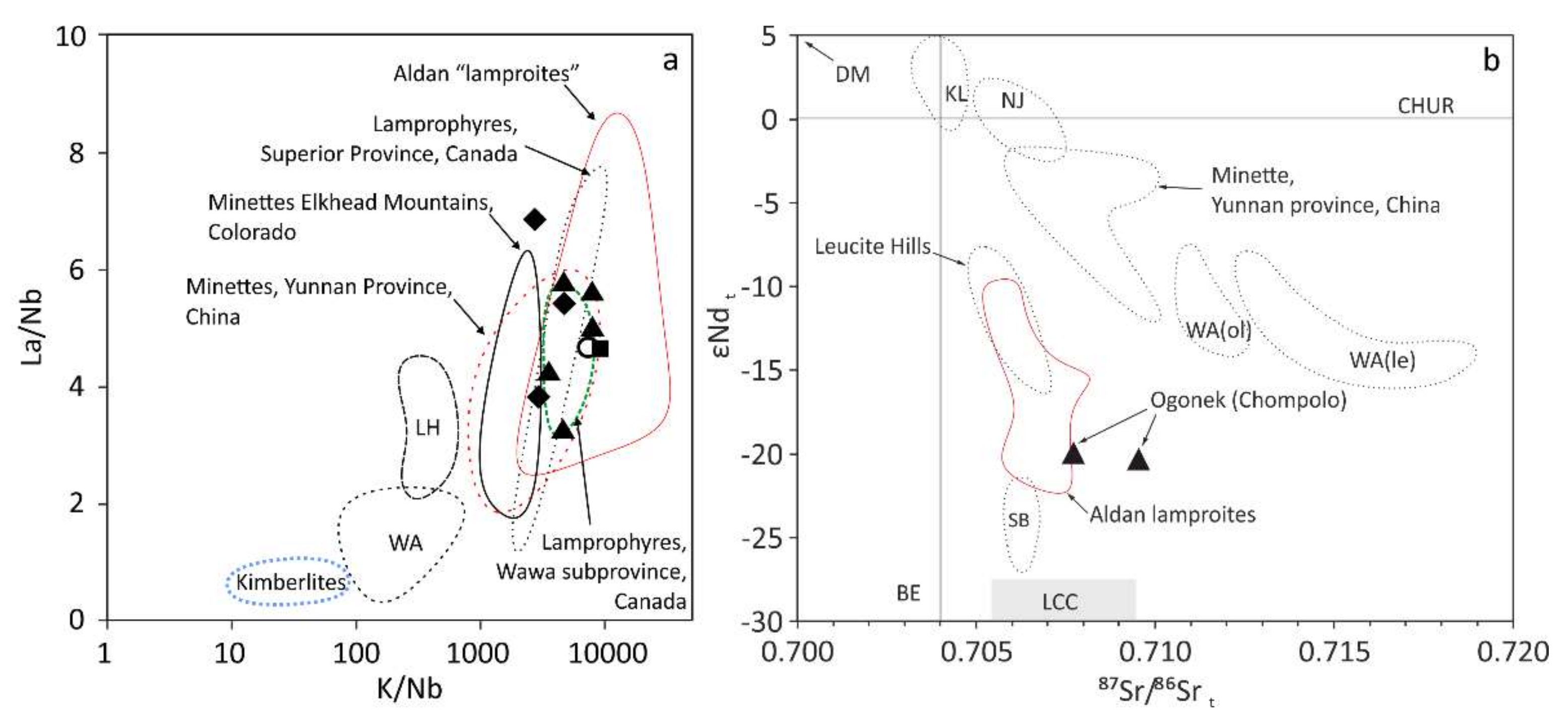
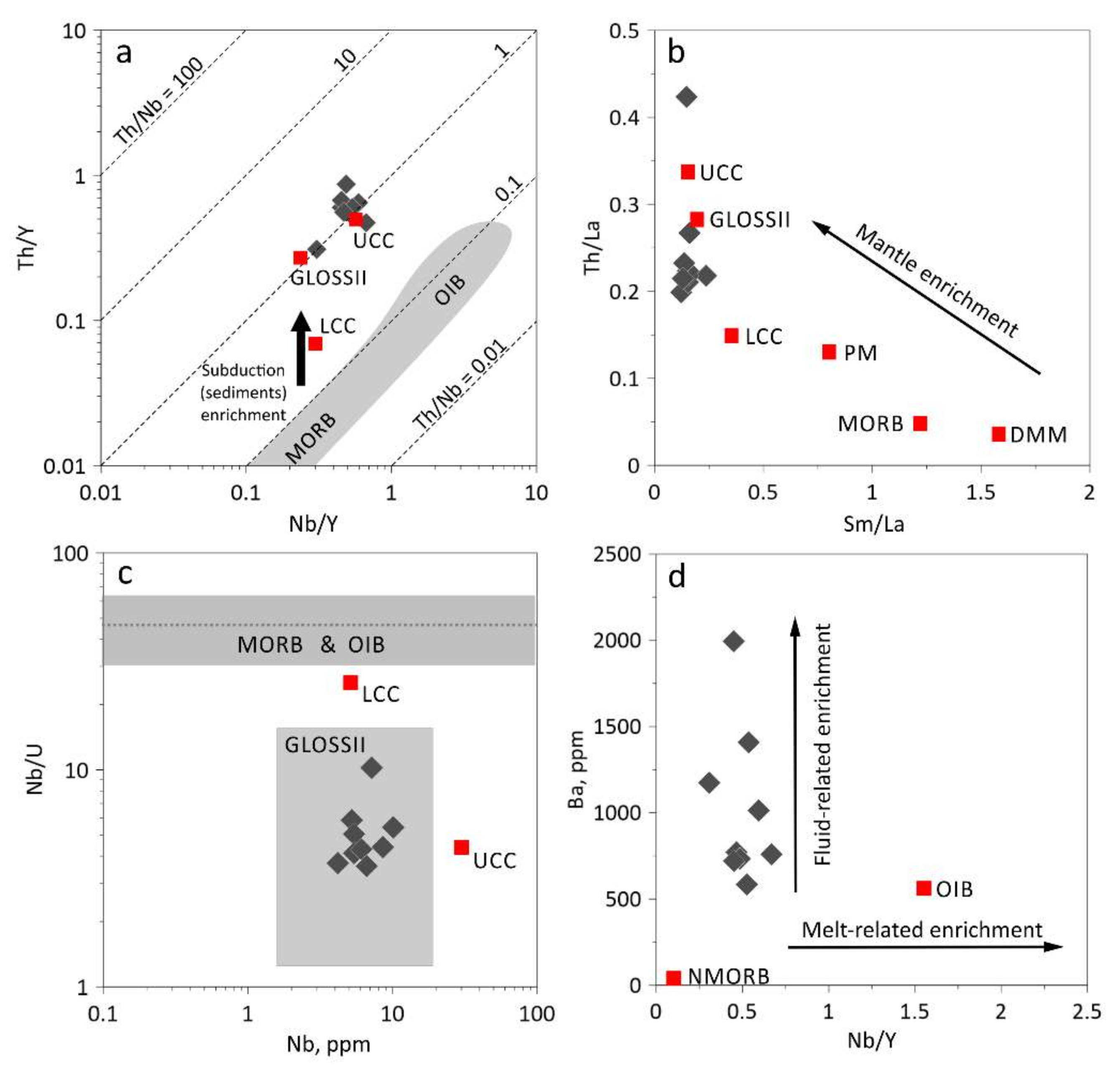
| Name Lat./Long. | Cognate Minerals | Mantle Xenocrysts | Secondary Minerals | ||
|---|---|---|---|---|---|
| Matrix | Phenocrysts | Accessory Minerals | |||
| Aldanskaya 58°43′56.7″/123°09′22.4″ | Kfs, Phl | Phl, Amp (Prg-Ed), Di-Aug, Ol1 | Prp, Di, Ol1, Cr-Spl, Pilm | Cal, Chl, Sme, Kln, Vrm | |
| Ogonek 58°49′51.7″/123°09′54.8″ | Kfs, Phl | Phl, rare Di-Aug, Ol1 | Ap | Prp, Di, Ol1, Cr-Spl | Cal, Chl, Gth, Sme, Kln, Vrm, Qz |
| Gornaya 58°41′20.5″/123°06′38.8″ | Kfs, Phl | Di-Aug, Phl | Ap | Prp, Di, En, Ol1, Cr-Spl, | Chl, Sme, Vrm, Gth |
| Sputnik 58°42′24.8″/123°09′38.5″ | Kfs | Phl, Amp (Mg-Hbl), Ol1 | Ap | Prp, Di, Ol1, Cr-Spl, | Chl, Sme, Vrm, Gth, |
| Pereval’naya 58°40′51.9″/122°59′58.6″ | Kfs, Phl | Di-Aug, Phl, rare Amp | Ap | Prp, Di, Cr-Spl, | Cal (Dol), Hem, Qz |
| Intrusion 104 58°47′18.4″/123°12′40.5″ | Kfs, Phl | Di-Aug, Phl, Ol1, rare Amp | Ap | - | Chl, Sme, Vrm |
| Object | n | UC | LC | E | DE | LPL | HPL | HTL | W | HD |
|---|---|---|---|---|---|---|---|---|---|---|
| Sputnik | 140 | 1.2 | 4.0 | 5.8 | 0.6 | 70.4 | 9.8 | 6.9 | 1.2 | 0.1 |
| Ogonek | 317 | 4.2 | 6.9 | 7.8 | 0.2 | 60.3 | 15.9 | 1.2 | 0.2 | 3.2 |
| Gornaya | 323 | 6.4 | 10.8 | 7.8 | 2.3 | 51.1 | 18.6 | 0.9 | 0.7 | 1.4 |
| Aldanskaya | 260 | 5.3 | 12.2 | 11.4 | 0.3 | 46.5 | 22.4 | 0.8 | 0.0 | 1.1 |
| Kilier-East | 18 | 33.7 | 32.0 | 18.5 | 0.0 | 10.7 | 5.1 | 0.0 | 0.0 | 0.0 |
| Perevalnaya | 131 | 25.8 | 71.9 | 2.3 | 0.0 | 0.0 | 0.0 | 0.0 | 0.0 | 0.0 |
| Intrusion 104 | 116 | 95.2 | 4.8 | 0.0 | 0.0 | 0.0 | 0.0 | 0.0 | 0.0 | 0.0 |
© 2020 by the authors. Licensee MDPI, Basel, Switzerland. This article is an open access article distributed under the terms and conditions of the Creative Commons Attribution (CC BY) license (http://creativecommons.org/licenses/by/4.0/).
Share and Cite
Nikolenko, E.I.; Lobov, K.V.; Agashev, A.M.; Tychkov, N.S.; Chervyakovskaya, M.V.; Sharygin, I.S.; Nikolenko, A.M. 40Ar/39Ar Geochronology and New Mineralogical and Geochemical Data from Lamprophyres of Chompolo Field (South Yakutia, Russia). Minerals 2020, 10, 886. https://doi.org/10.3390/min10100886
Nikolenko EI, Lobov KV, Agashev AM, Tychkov NS, Chervyakovskaya MV, Sharygin IS, Nikolenko AM. 40Ar/39Ar Geochronology and New Mineralogical and Geochemical Data from Lamprophyres of Chompolo Field (South Yakutia, Russia). Minerals. 2020; 10(10):886. https://doi.org/10.3390/min10100886
Chicago/Turabian StyleNikolenko, Evgeny I., Konstantin V. Lobov, Alexey M. Agashev, Nikolay S. Tychkov, Maria V. Chervyakovskaya, Igor S. Sharygin, and Anna M. Nikolenko. 2020. "40Ar/39Ar Geochronology and New Mineralogical and Geochemical Data from Lamprophyres of Chompolo Field (South Yakutia, Russia)" Minerals 10, no. 10: 886. https://doi.org/10.3390/min10100886
APA StyleNikolenko, E. I., Lobov, K. V., Agashev, A. M., Tychkov, N. S., Chervyakovskaya, M. V., Sharygin, I. S., & Nikolenko, A. M. (2020). 40Ar/39Ar Geochronology and New Mineralogical and Geochemical Data from Lamprophyres of Chompolo Field (South Yakutia, Russia). Minerals, 10(10), 886. https://doi.org/10.3390/min10100886




